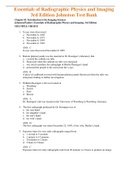Essentials of Radiographic Physics and Imaging 3rd Edition Johnston Test Bank Chapter 01: Introduction to the Imaging Sciences Johnston/Fauber: Essentials of Radiographic Physics and Imaging, 3rd Edition MULTIPLE CHOICE 1. X-rays were discovered a. November 8, 1805 b. November 8, 1875 c. November 8, 1895 d. November 8, 1985 ANS: C X-rays were discovered November 8, 1895. 2. Barium platinocyanide was the material in Dr. Roentgen’s laboratory that a. covered the cathode ray tube b. fluoresced when the cathode ray tube was energized c. was used to produce the radiograph of Bertha Roentgen’s hand d. protected the people in the room from the x-rays ANS: B A piece of cardboard covered with barium platinocyanide fluoresced when the tube was energized, leading to further investigation. 3. Wilhelm Roentgen’s lab was located in a. Wurzburg b. Zurich c. Paris d. Boston ANS: A Dr. Roentgen’s lab was located at the University of Wurzburg in Wurzburg, Germany. 4. The first radiograph produced by Dr. Roentgen was of a. his own hand b. his daughter’s hand c. his son’s hand d. his wife’s hand ANS: D The first radiograph was taken December 22, 1895, of his wife, Bertha’s, hand. 5. Exposure times for very early radiographs ranged from a. 1 second to 5 seconds b. 1 minute to 15 minutes c. 20 minutes to 2 hours d. 2 hours to 5 hours ANS: C Exposure times for early radiographs took from 20 minutes to 2 hours to produce an image. 6. Acute radiodermatitis was a. the radiation burn resulting from excessive exposure to x-rays b. common among early patients and operators of x-ray equipment c. a delayed reaction to excessive x-ray exposure d. all of these ANS: D Early on, the excessive radiation exposure to many operators and patients resulted in radiation burns, a delayed response to the exposure. 7. Who brought attention to the dangers of x-rays? a. Wilhelm Roentgen. b. Bertha Roentgen. c. Crookes. d. Thomas Edison. ANS: D Thomas Edison, the famous American inventor, suffered a radiation burn and brought attention to the dangers of x -rays. 8. An example of how x-rays were used for entertainment or business gain in a dangerous manner was the a. fluoroscopic shoe fitter b. x-ray stove polish c. x-ray headache tablets d. x-ray golf balls ANS: A Although the stove polish, headache tablets, an d golf balls used “x -ray” in their names, the shoe fitter actually exposed shoppers to radiation. 9. Mass, length, and time are considered a. fundamental quantities b. derived quantities c. radiologic quantities d. none of these ANS: A Mass, length, and time are the most basic or fundamental quantities. 10. Velocity, acceleration, and work are a. fundamental quantities b. derived quantities c. radiologic quantities d. none of these ANS: B Along with force, momentum and power, velocity, acceleration, and work are derived from the fundamental quantities. 11. Exposure, dose, and dose equivalent are a. fundamental quantities b. derived quantities c. radiologic quantities d. none of these ANS: C Along with the measure of radioactivity, dose, dose equivalent, and exposure are radiologic quantities. 12. The metric system is also known as the a. British system b. System International (SI) c. System of Units (SU) d. French system ANS: B The metric system is also known as the System International (SI). 13. In the SI system the unit of measure for mass is a. pound b. gram c. kilogram d. ton ANS: C The SI system uses kilogram to quantify mass. 14. In the SI system the unit of measure for length is a. meter b. kilometer c. foot d. mile ANS: A The SI system uses meter to quantify length. 15. In the SI system the unit of measure for time is a. minute b. second c. hour d. day ANS: B The SI system uses second to quantify time. 16. In the British system the unit of measure for mass is a. pound b. gram c. kilogram d. ton ANS: A The British system uses pound to quantify mass. 17. In the British system the unit of measure for length is a. meter b. kilometer c. foot d. mile ANS: C The British system uses foot to quantify length. 18. In the British system the unit of measure for time is a. minute b. second c. hour d. day ANS: B The British system uses second to quantify time. 19. is equal to distance traveled divided by the time needed to cover that distance. a. Work b. Momentum c. Velocity d. Acceleration ANS: C Distance traveled divided by the time needed to cover that distance is the formula to derive velocity. 20. Meters per second squared (m/s2) is the unit of measure of a. velocity b. momentum c. force d. acceleration ANS: D Meters per second squared (m/s2) is the unit of measure of acceleration. 21. Newton is the unit of measure of a. velocity b. momentum c. force d. acceleration ANS: C Force is measured in Newtons. 22. Kilograms -meters per second (kg-m/s) is the unit of measure of






